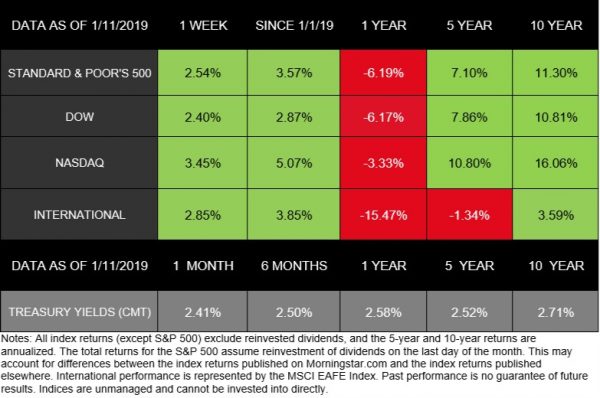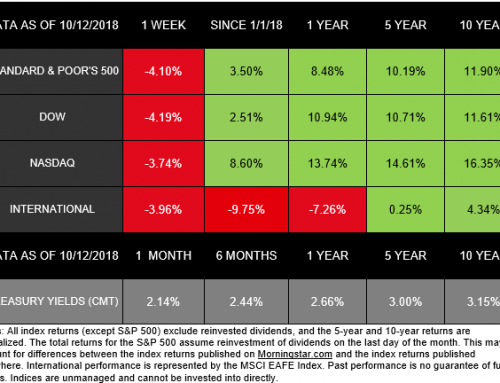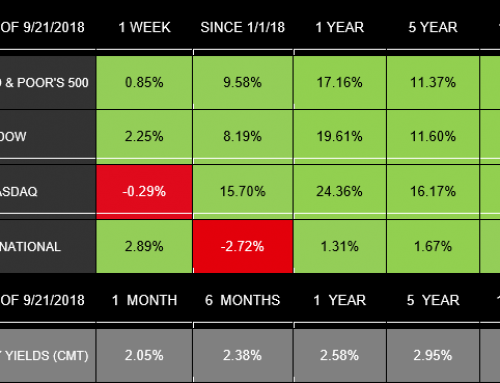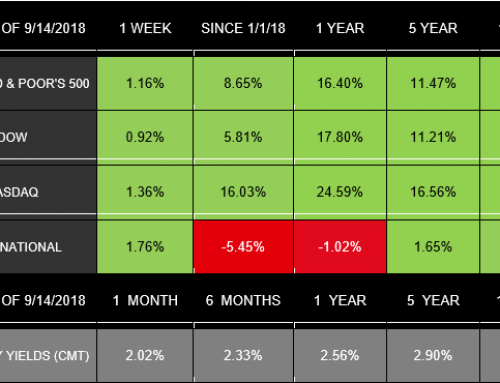After months of volatility, markets relaxed a bit last week. For the first time since October, the S&P 500 went 5 days without a 1% gain or loss.[i] The Cboe Volatility Index, or VIX, also fell to lower than 20—in December, it spiked above 35.[ii]
For the week, the S&P 500 added 2.54%, the Dow gained 2.40%, and the NASDAQ increased 3.45%. All three indexes are in positive territory for 2019.[iii] International stocks in the MSCI EAFE grew as well, with a 2.85% weekly gain.[iv]
What drove last week’s gains?
Updates on trade and monetary policy contributed to investor decisions, yet again.[v]
- The Federal Reserve made dovish comments.
Last week, multiple Fed officials gave speeches indicating our central bank would carefully approach its interest rate decisions in 2019. Fed Chairman Jerome Powell described the policies as “flexible” and “patient.”[vi]
- A trade resolution seemed more likely.
Many investors believe that efforts to resolve trade tension between the U.S. and China made progress last week. On Wednesday, January 9, talks concluded in Beijing after three days of negotiations, and China said the “in-depth” meetings made a resolution possible.[vii] The next day, U.S. Treasury Secretary Steve Mnuchin announced that a high-level Chinese policy advisor is coming to D.C. later this month for further talks.[viii]
What is ahead?
Last week’s trade and policy headlines seemed to ease some of the risks on investors’ minds.[ix] However, both challenges and opportunities remain.
This week marks the beginning of U.S. corporate earnings season. Analysts have low expectations for companies’ 4th-quarter performance, especially after a number of large corporations released warnings about their results. However, analysts still predict that S&P 500 companies experienced 14.5% profit growth. In addition, the generally sour, pessimistic mood surrounding earnings could support equities in two ways: 1) Investors may not react strongly if companies miss projections, and 2) any companies that have surprisingly good results could see stock price jumps.[x]
Along with earnings results, investors will be paying close attention to companies’ commentary on business in China.[xi]Some experts believe Chinese economic growth is slowing, which is already affecting market performance. On Friday, markets stumbled a bit as analysts considered data and commentary on China’s economy. These details will remain important to watch—and see how it relates to trade.[xii]
In addition, while the U.S. federal government shutdown has not yet had a large market impact, if it continues for too long, it could sizably affect the economy.[xiii]
We will continue to monitor these and other financial perspectives as we determine where the markets are—and what may be on the horizon. If you have any questions, we’re here to talk and listen.
ECONOMIC CALENDAR
Tuesday: PPI-FD
Wednesday: Retail Sales, Housing Market Index
Thursday: Housing Starts, Jobless Claims
Friday: Industrial Production, Consumer Sentiment

Investing involves risk including the potential loss of principal. No investment strategy can guarantee a profit or protect against loss in periods of declining values.
Diversification does not guarantee profit nor is it guaranteed to protect assets.
International investing involves special risks such as currency fluctuation and political instability and may not be suitable for all investors.
The Standard & Poor’s 500 (S&P 500) is an unmanaged group of securities considered to be representative of the stock market in general.
The Dow Jones Industrial Average is a price-weighted average of 30 significant stocks traded on the New York Stock Exchange and the NASDAQ. The DJIA was invented by Charles Dow back in 1896.
The Nasdaq Composite is an index of the common stocks and similar securities listed on the NASDAQ stock market and is considered a broad indicator of the performance of stocks of technology companies and growth companies.
The MSCI EAFE Index was created by Morgan Stanley Capital International (MSCI) that serves as a benchmark of the performance in major international equity markets as represented by 21 major MSCI indices from Europe, Australia, and Southeast Asia.
The 10-year Treasury Note represents debt owed by the United States Treasury to the public. Since the U.S. Government is seen as a risk-COMPLIMENTARY borrower, investors use the 10-year Treasury Note as a benchmark for the long-term bond market.
Opinions expressed are subject to change without notice and are not intended as investment advice or to predict future performance.
Past performance does not guarantee future results.
You cannot invest directly in an index.
Consult your financial professional before making any investment decision.
Fixed income investments are subject to various risks including changes in interest rates, credit quality, inflation risk, market valuations, prepayments, corporate events, tax ramifications and other factors.
These are the views of Platinum Advisor Strategies, LLC, and not necessarily those of the named representative,
Broker dealer or Investment Advisor, and should not be construed as investment advice. Neither the named representative nor the named Broker dealer or Investment Advisor gives tax or legal advice. All information is believed to be from reliable sources; however, we make no representation as to its completeness or accuracy. Please consult your financial advisor for further information.
By clicking on these links, you will leave our server, as the links are located on another server. We have not independently verified the information available through this link. The link is provided to you as a matter of interest. Please click on the links below to leave and proceed to the selected site.
http://performance.morningstar.com/Performance/index-c/performance-return.action?t=@CCO
[iv] https://www.msci.com/end-of-day-data-search
[vi] https://www.marketwatch.com/story/stock-futures-edge-lower-ahead-of-inflation-data-2019-01-11
[viii] https://www.marketwatch.com/story/stock-futures-edge-lower-ahead-of-inflation-data-2019-01-11
[xiii] https://www.marketwatch.com/story/stock-futures-edge-lower-ahead-of-inflation-data-2019-01-11




